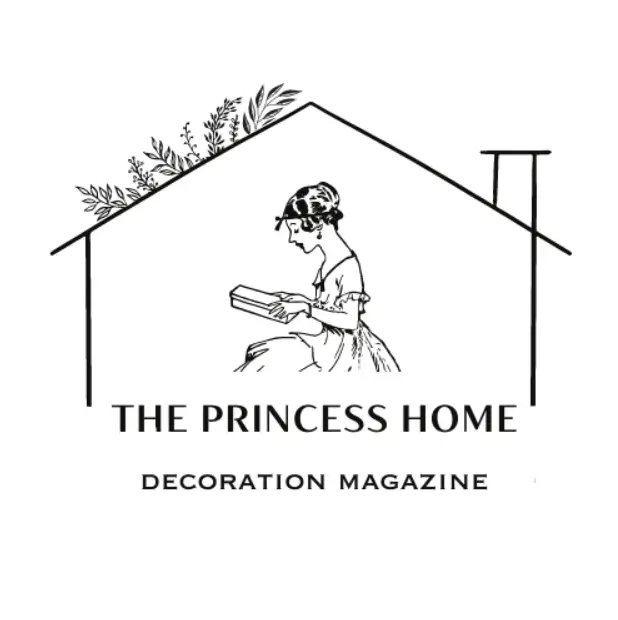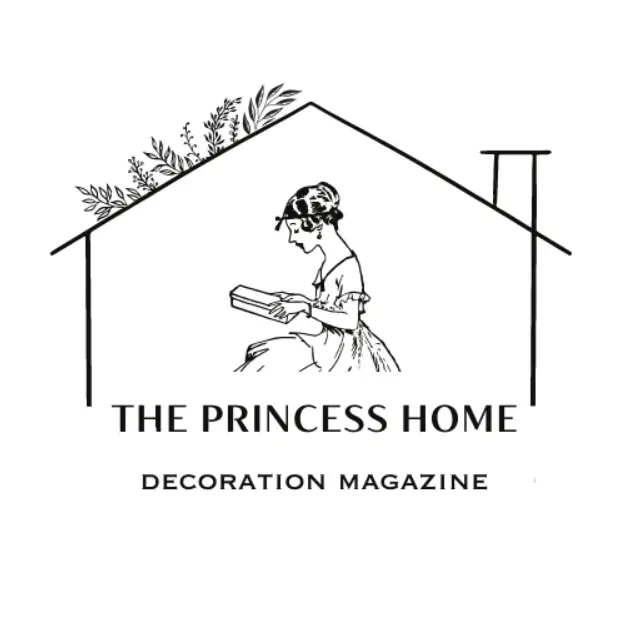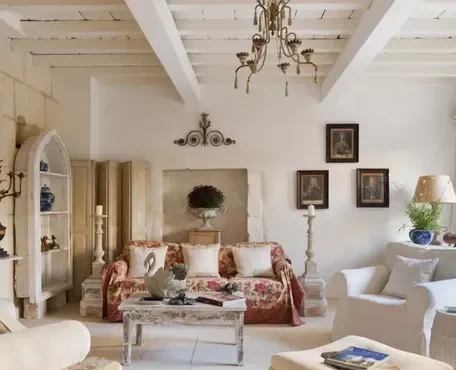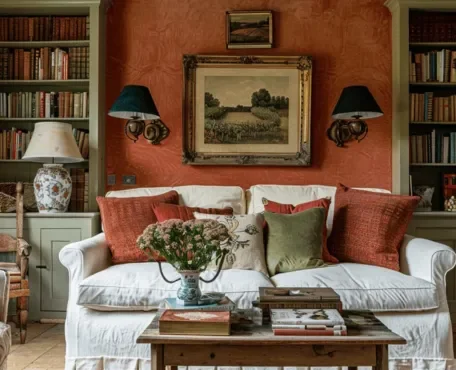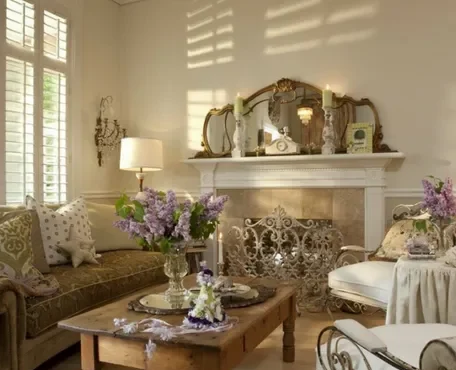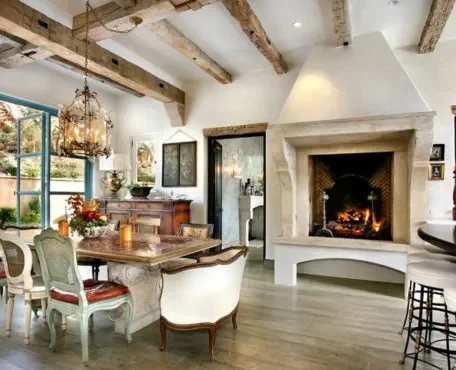
Transforming your home into a luxurious haven requires more than just splurging on high-end items; it’s about thoughtful design choices and avoiding common decor pitfalls. A truly luxurious home balances style, comfort, and sophistication. Here are some common decor mistakes to avoid and tips on how to achieve that opulent look.
Here are detailed insights on how to transform your home into a haven of elegance and sophistication.

1. Cluttered Spaces
Mistake: Over-decorating or cluttering spaces with too many items.
Over-decorating or cluttering spaces with too many items can make a room feel chaotic and overwhelming. When every surface is covered and every corner is filled, it can be difficult to appreciate the individual elements, and the space may lack a cohesive and intentional look.

Solution: Embrace minimalism. A luxurious home often follows the “less is more” principle. Select a few statement pieces and let them shine. Clear surfaces and organized spaces exude a sense of calm and sophistication. Use elegant storage solutions to keep clutter out of sight. Over-decorating or cluttering spaces with too many items can detract from the intended design and create a chaotic atmosphere.
Here are some tips to avoid this common mistake:
1.Choose Key Pieces:
Focus on a few statement pieces that reflect the style and theme you want to convey. Let these items be the focal points of the room.
2.Embrace Negative Space:
Allow for empty spaces on shelves, walls, and surfaces. This helps to balance the room and makes it feel more open and airy.
3.Prioritize Functionality:
Ensure that each item in the room has a purpose, whether it’s for utility or aesthetic. Avoid items that do not add value to the space.
4.Use Storage Wisely:
Incorporate stylish storage solutions to keep clutter out of sight. Baskets, bins, and cabinets can help maintain a clean and organized look.
5.Rotate Decor Seasonally:
Instead of displaying all your decor at once, rotate items seasonally. This keeps your space fresh and prevents it from feeling overcrowded.
6.Follow the Rule of Thirds:
When arranging items on a shelf or table, group them in threes. This creates a balanced and visually appealing display without overcrowding.
7.Mind the Scale:
Ensure that decor pieces are appropriately scaled for the room. Large items in small spaces or too many small items in a large space can create a cluttered feel.
8.Prioritize Functionality:
Choose decor items that also serve a purpose to avoid unnecessary clutter. For example, a stylish storage ottoman or a decorative tray that can hold remote controls and other small items.
9.Create Focal Points:
Instead of scattering items throughout the space, create focal points by grouping similar objects together. This draws the eye to specific areas without overwhelming the entire room.
By keeping these tips in mind, you can create a harmonious and inviting space without falling into the trap of over-decorating.

2. Ignoring Lighting
Mistake: Relying solely on overhead lighting.
Relying solely on overhead lighting is a common mistake that can result in a flat, uninviting atmosphere in a room. Overhead lights often cast harsh shadows and can make a space feel cold and unwelcoming. Additionally, they typically don’t provide adequate illumination for specific tasks or create a cozy ambiance.

Solution: Layer your lighting with a mix of ambient, task, and accent lights. Chandeliers, floor lamps, and table lamps can create a warm and inviting ambiance. Use dimmers to adjust the mood. Incorporate statement lighting fixtures that double as decor pieces, adding to the luxurious feel.
To avoid this mistake, it’s important to incorporate a variety of light sources to create a more balanced and inviting environment. Here are some tips:
1.Layered Lighting:
Combine ambient, task, and accent lighting to achieve a well-rounded lighting scheme. Ambient lighting provides overall illumination, task lighting focuses on specific areas for activities like reading or cooking, and accent lighting highlights architectural features or decorative elements.
2.Table &Floor Lamps:
These add warmth and create cozy spots within a room. They also provide flexibility in directing light exactly where it’s needed.
3.Wall Sconces:
Sconces can add both ambient and task lighting, especially in hallways, bathrooms, or as bedside lights. They also contribute to the room’s design aesthetic.
4.Under-Cabinet &Task Lighting:
n kitchens and workspaces, under-cabinet lights and task lighting ensure that countertops and work areas are well-lit, making tasks easier and reducing eye strain.
5.Dimmers and Smart Lighting:
Installing dimmers allows you to adjust the intensity of the lighting to suit different moods and activities. Smart lighting systems offer even more flexibility, allowing you to control lighting through apps or voice commands.
6.Decorative Lighting:
Chandeliers, pendant lights, and other decorative fixtures can serve as focal points in a room, adding style and personality while also providing necessary illumination.
By thoughtfully combining these different types of lighting, you can create a dynamic and inviting atmosphere in any space.

3. Poor Furniture Arrangement
Mistake: Pushing all furniture against the walls.
Pushing all furniture against the walls is a common mistake that can make a room feel uninviting and awkward. This arrangement often leaves a large, empty space in the center of the room, which can detract from the coziness and functionality of the space.

Solution: Create intimate seating areas by arranging furniture away from walls. Use area rugs to define spaces and anchor furniture. Ensure there is a natural flow and conversation-friendly arrangement. This not only makes the room feel cozier but also more luxurious.
Here are some tips to avoid this mistake and create a more inviting and practical layout:
1.Create Conversation Areas:
Arrange furniture to facilitate conversation. Place sofas and chairs so they face each other, with a coffee table or ottoman in the center. This encourages interaction and makes the space feel more intimate.
2.Float Furniture:
Don’t be afraid to pull furniture away from the walls. Floating pieces in the middle of the room can create a more balanced and dynamic layout. Use area rugs to anchor these arrangements and define different zones within the space.
3.Use Furniture to Define Spaces:
In open-concept living areas, use furniture to delineate different functional zones, such as a living area, dining area, and workspace. This helps to create a sense of order and flow.
4.Consider Traffic Flow:
Ensure there are clear pathways for movement throughout the room. Arrange furniture so it doesn’t obstruct natural walking paths, and leave enough space between pieces for easy navigation.
5.Utilize Corners and Nooks:
Corners and small nooks can be perfect for additional seating areas, reading corners, or small desks. This makes the most of the available space and adds interest to the room.
6.Balance and Proportion:
Ensure that furniture pieces are in proportion to the size of the room. Oversized furniture can overwhelm a small space, while too-small pieces can make a large room feel sparse. Balance the arrangement by distributing furniture evenly and considering the visual weight of each piece.
7.Focus on Functionality:
Think about how you use the space and arrange furniture to support those activities. For example, if you watch TV in the living room, make sure the seating is oriented toward the screen. If you entertain often, ensure there’s ample seating and surfaces for guests to place drinks and snacks.
8.Incorporate Multifunctional Pieces:
Use furniture that can serve multiple purposes, such as ottomans with storage, fold-out sofas, or extendable dining tables. This maximizes the functionality of the space and can make smaller rooms more versatile.
By thoughtfully arranging furniture with these principles in mind, you can create a more inviting, functional, and aesthetically pleasing room.

4. Overlooking Textures
Mistake: Using only one type of texture or material.
Overlooking textures in interior design and relying on only one type of texture or material can make a space feel flat and uninspired. Textures add depth, interest, and dimension to a room, making it more inviting and visually appealing.

Solution: Mix different textures to add depth and interest to your decor. Combine smooth and rough textures, soft and hard materials. Think plush velvet sofas, silk cushions, a chunky knit throw, and a sleek glass coffee table. Layering textures creates a rich, luxurious feel.
Here are some tips to incorporate a variety of textures effectively:
1.Mix Materials:
Combine different materials such as wood, metal, glass, and fabric to create a rich and layered look. For example, pair a leather sofa with a soft wool throw, a wooden coffee table, and a metal floor lamp.
2.Layer Fabrics:
Use a mix of fabrics in your decor, such as cotton, linen, velvet, and silk. Layering fabrics on sofas, chairs, and beds with throws, pillows, and blankets can add warmth and comfort to the space.
3.Incorporate Natural Elements:
Natural materials like wood, stone, rattan, and jute bring an organic and tactile quality to a room. Use wooden furniture, stone countertops, rattan baskets, and jute rugs to introduce these elements.
4.Use Rugs and Carpets:
Rugs and carpets can add texture and define areas within a room. Choose rugs with different pile heights, patterns, and materials to create contrast and interest.
5.Play with Patterns:
Incorporate patterns through textiles, wallpapers, and accessories. Patterns can add visual texture and make a room feel more dynamic. Mix and match patterns, but ensure they share a common color palette for a cohesive look.
6.Add Wall Treatments:
Consider textured wall treatments such as shiplap, beadboard, wallpaper, or textured paint. These can add depth and character to your walls, making the room feel more sophisticated.
7.Use Accessories:
Accessories like woven baskets, ceramic vases, metal trays, and glass decor items can introduce various textures. These small touches can make a big difference in the overall feel of the space.
8.Incorporate Plants:
Plants add a natural texture and bring life to a room. The different shapes, sizes, and textures of leaves can create a lush and vibrant environment.
9.Mix Finishes:
Use a mix of finishes in your decor, such as matte, glossy, and metallic. This contrast can create a more layered and interesting look. For instance, pair a matte painted wall with glossy tiles and metallic light fixtures.
10.Consider Architectural Details:
Architectural elements like exposed beams, brick walls, and textured ceilings can add inherent texture to a space. If your home has these features, highlight them to add character.
By thoughtfully incorporating a variety of textures and materials, you can create a more engaging, comfortable, and visually appealing space that reflects your personal style and enhances the overall ambiance.

5. Neglecting Windows
Mistake: Leaving windows bare or using cheap window treatments.
Neglecting windows by leaving them bare or using cheap window treatments can significantly impact the overall look and feel of a room. Proper window treatments not only enhance the aesthetic appeal but also provide practical benefits like light control, privacy, and insulation.

Solution: Invest in high-quality window treatments. Floor-to-ceiling drapes in luxurious fabrics like silk or velvet add elegance. Consider custom treatments for a perfect fit. Roman shades or plantation shutters are also excellent choices for a refined look.
Here are some tips to avoid this mistake and make the most of your windows:
1.Choose Quality Materials:
Invest in high-quality materials for your window treatments. Fabrics like linen, silk, and velvet add a touch of luxury and elegance to your space, while durable materials ensure longevity.
2.Layer Window Treatments:
Combine different types of window treatments for a more sophisticated look. For instance, pair sheer curtains with heavier drapes or use blinds with a valance. This approach allows for greater control over light and privacy.
3.Consider Functionality:
Think about the primary function of each room and choose window treatments accordingly. For bedrooms, opt for blackout curtains or shades to ensure a good night’s sleep. In living areas, consider treatments that allow natural light while providing privacy.
4.Tailor to the Room’s Style:
Match window treatments to the room’s overall decor style. For a modern look, sleek and simple roller shades or vertical blinds work well. For a more traditional space, opt for elegant drapes or Roman shades with classic patterns.
5.Custom Fit:
Custom window treatments tailored to your window’s exact measurements can make a significant difference in appearance and functionality. They ensure a perfect fit, avoiding gaps that can let in unwanted light or compromise privacy.
6.Add Hardware Details:
Don’t overlook the hardware. Stylish curtain rods, finials, and tiebacks can enhance the overall look of your window treatments. Choose finishes that complement your room’s decor.
7.Play with Colors and Patterns:
Use window treatments as an opportunity to introduce color and pattern into your room. Bold colors or interesting patterns can serve as a focal point, while neutral tones can create a serene backdrop.
8.Incorporate Light Control:
Consider the level of light control you need. Sheer curtains allow for soft, diffused light, while layered treatments with blinds or shades provide more control over light levels.
9.Prioritize Energy Efficiency:
Use window treatments that help with insulation to improve energy efficiency. Cellular shades, thick drapes, or thermal curtains can help regulate indoor temperatures and reduce energy costs.
10.Enhance Architectural Features:
Highlight architectural features like bay windows or high ceilings with well-chosen window treatments. Floor-to-ceiling drapes can accentuate height, while custom-fit shades can perfectly frame unique window shapes.
11.Maintenance and Cleanliness:
Choose window treatments that are easy to maintain. Fabrics that are easy to clean or that don’t attract too much dust are practical choices, especially for households with pets or allergies.
12.Coordinate with the Room:
Ensure that window treatments complement other elements in the room, such as furniture, rugs, and wall colors. This creates a cohesive and harmonious look.
By thoughtfully selecting and installing window treatments, you can enhance the beauty and functionality of your windows, contributing to the overall ambiance and comfort of your home.

6. Skimping on Art and Accessories
Mistake: Choosing generic art or none at all.
When it comes to home decor, opting for generic art or skipping it altogether can detract from the uniqueness and character of your space. Art and accessories play a crucial role in personalizing your home, making it feel inviting and truly yours.

Solution: Invest in unique art pieces that reflect your personal style. Art adds character and can be a focal point in a room. Complement art with carefully selected accessories like sculptures, vases, and decorative objects. Avoid overcrowding; instead, curate a collection that adds to the room’s luxury.
Here’s why avoiding generic art and embracing thoughtfully chosen pieces is important:
1.Personal Expression:
Art reflects your personality and interests. Generic pieces can make a space feel impersonal and bland. Choose art that resonates with you, whether it’s a favorite painting, a photograph from a meaningful trip, or a custom piece.
2.Visual Interest:
Art adds depth and intrigue to your walls. It can serve as a focal point or complement other design elements, making your space visually engaging.
3.Conversation Starters:
Unique and meaningful art pieces often spark conversations, giving guests a glimpse into your tastes and experiences.
4.Emotional Impact:
Art can evoke emotions and set the mood of a room. Whether it’s calming, energizing, or thought-provoking, the right art can enhance your home’s atmosphere.
5.Accessorizing:
Accessories, like sculptures, vases, and textiles, work alongside art to enhance your decor. They can introduce color, texture, and personality, making your space feel more curated and cohesive.
To avoid the mistake of choosing generic art or none at all, invest in pieces that reflect your style and interests. Mix and match different types of art and accessories to create a space that feels uniquely yours.

7. Ignoring Scale and Proportion
Mistake: Using furniture and decor items that are too large or too small for the space.
Ignoring scale and proportion when decorating can lead to a disjointed and uncomfortable space. Ensuring that furniture and decor items fit well within your room’s dimensions is key to achieving a harmonious and aesthetically pleasing environment.

Solution: Pay attention to scale and proportion. Choose furniture that fits the size of your room and leaves enough space for movement. Large rooms can handle grand pieces, while smaller spaces benefit from more compact, multifunctional furniture.
Here’s why paying attention to scale and proportion matters:
1.Balance and Harmony:
Properly scaled items create a sense of balance and cohesion in a room. Oversized furniture in a small space can make it feel cramped, while tiny pieces in a large room can appear lost and ineffective.
2.Functionality:
Furniture and decor that are appropriately sized for the space enhance its functionality. Too-large pieces can obstruct movement and make the room less usable, while too-small items can fail to serve their intended purpose effectively.
3.Visual Appeal:
Items that are well-proportioned to the space contribute to its overall visual appeal. They help maintain a pleasing flow and make the room more inviting.
4.Comfort:
Scale and proportion affect comfort levels. For instance, a massive couch in a small living room can overwhelm the space, making it less comfortable for everyday use.
5.Spatial Perception:
Correctly scaled furniture and decor can alter the perception of space. Properly sized items can make a small room feel larger and a large room feel cozier.
To avoid the mistake of using furniture and decor items that are too large or too small for the space, measure your room and plan accordingly. Consider the following tips:
1.Measure First:
Always measure your space and the furniture before purchasing. Consider the dimensions of the room and the scale of other items within it.
2.Proportional Grouping:
Arrange furniture and decor in groups that are proportionate to each other. A large sofa pairs well with a substantial coffee table, while a delicate side table complements a smaller accent chair.
3.Mind the Ceiling Height:
Take the ceiling height into account when choosing furniture. Tall ceilings can accommodate taller furniture, while lower ceilings require more modestly sized pieces.
4.Visual Weight:
Consider the visual weight of items. Heavy, bulky furniture should be balanced with lighter, airier pieces to maintain harmony.
By paying attention to scale and proportion, you can create a well-balanced, functional, and visually appealing space that feels comfortable and inviting.

8. Disregarding Color Harmony
Mistake: Using too many bold colors without a cohesive scheme.
Disregarding color harmony by using too many bold colors without a cohesive scheme can result in a chaotic and overwhelming space. Color plays a crucial role in setting the mood and style of a room, so it’s essential to use it thoughtfully.

Solution: Stick to a cohesive color palette. Neutral tones with pops of color create a timeless, luxurious look. Use bold colors sparingly as accents. Incorporate metallics like gold, silver, or bronze for added glamour.
Here’s why maintaining color harmony is important:
1.Visual Cohesion:
A cohesive color scheme ties a room together, creating a unified and harmonious look. Disjointed colors can make a space feel fragmented and cluttered.
2.Mood Setting:
Colors evoke emotions and influence the atmosphere of a room. A well-chosen color palette can create a calming, energizing, or welcoming environment, while clashing colors can cause discomfort and agitation.
3.Aesthetic Appeal:
Harmonious colors enhance the aesthetic appeal of your space, making it more attractive and inviting. They help highlight key design elements and create a pleasing visual flow.
4.Balance:
A balanced color scheme ensures that no single color overwhelms the space. Too many bold colors can compete for attention, leading to a visually jarring experience.
5.Complementing Decor:
A cohesive color scheme allows furniture, accessories, and decor elements to complement each other, enhancing the overall design and style of the room.
To avoid the mistake of using too many bold colors without a cohesive scheme, consider the following tips:
6.Choose a Base Color:
Start with a neutral or muted base color for walls, large furniture pieces, and flooring. This provides a foundation that other colors can build upon.
7.Select an Accent Palette:
Choose one or two bold accent colors to add vibrancy and interest. These can be used in smaller doses, such as in pillows, artwork, or decorative accessories.
1.Follow the 60-30-10 Rule:
This rule suggests using 60% of a dominant color (often the base color), 30% of a secondary color (usually a complementary or contrasting color), and 10% of an accent color. This creates a balanced and harmonious look.
2.Use a Color Wheel:
A color wheel can help you select complementary, analogous, or triadic color schemes. Complementary colors are opposite each other on the wheel, creating contrast, while analogous colors are next to each other, providing a more subtle harmony.
3.Test Before Committing:
Before committing to a color scheme, test paint samples on your walls and gather fabric swatches. Observe how they look in different lighting conditions to ensure they work well together.
4.Consider the Whole House:
If you have an open floor plan or rooms that flow into each other, ensure that your color schemes are harmonious throughout. This creates a sense of continuity and cohesion.
By maintaining color harmony, you can create a space that is visually appealing, balanced, and inviting, making it a pleasure to live in and share with others.

9. Inadequate Use of Mirrors
Mistake: Using mirrors only in bathrooms.
Mirrors are often relegated to bathrooms, missing the opportunity to enhance other spaces. Mirrors can create the illusion of more space, amplify light, and serve as decorative elements in various rooms. Inadequate use of mirrors can result in missed opportunities to enhance the visual appeal and functionality of a space.

Solution: Use mirrors strategically to reflect light and make spaces feel larger. A statement mirror can be a focal point in a living room, entryway, or bedroom. Mirrors framed in luxurious materials like brass or wood add an elegant touch.
Here are some common pitfalls:
1.Poor Placement:
Mirrors placed in areas where they don’t reflect anything interesting or useful can feel like wasted opportunities. For example, placing a mirror where it only reflects a blank wall or a cluttered space may not add much value.
2.Scale Issues:
Using mirrors that are too small or too large for the space can disrupt the balance. A small mirror in a large room might get lost, while an oversized mirror might overwhelm the space.
3.Lack of Consideration for Reflection:
Mirrors should reflect beautiful views, artwork, or interesting architectural features. Failing to consider what a mirror will reflect can result in less visually appealing outcomes.
4.Overusing Mirrors:
While mirrors can enhance a room, too many mirrors can create a disjointed or chaotic feeling. It’s important to strike a balance and use mirrors purposefully.
5.Ignoring Style and Frame:
Mirrors should complement the room’s decor style. A mirror with an incongruent frame or design can look out of place and detract from the overall aesthetic.
6.Neglecting Light:
Mirrors can amplify natural and artificial light, brightening up a space. Not using mirrors to enhance lighting can result in a dull and less inviting room.
Strategically placing mirrors can make a room feel larger, brighter, and more cohesive.

10. Forgetting About Scent
Mistake: Neglecting the importance of a pleasant scent in your home.
A pleasant scent can significantly enhance the ambiance of your home, making it more inviting and comfortable. Ignoring this aspect can lead to a less enjoyable environment.

Solution: Incorporate fragrances that enhance the luxurious feel. Use scented candles, diffusers, or fresh flowers. Choose sophisticated scents like vanilla, sandalwood, or lavender to create a welcoming atmosphere.
Here’s how to avoid this mistake and ensure your home always smells delightful:
1.Scented Candles:
Choose high-quality scented candles that complement your home’s decor and create a warm, inviting atmosphere. Opt for scents that you find relaxing and pleasant.
2.Essential Oil Diffusers:
Use essential oil diffusers to introduce subtle, natural fragrances. Essential oils like lavender, eucalyptus, and citrus can improve mood and air quality.
3.Fresh Flowers:
Place fresh flowers in various rooms to add a natural and refreshing scent. Seasonal blooms can also enhance the overall decor.
4.Cleanliness:
Regular cleaning is crucial in maintaining a fresh-smelling home. Ensure that carpets, upholstery, and fabrics are clean, as they can absorb odors.
5.Baking and Cooking Scents:
Occasionally bake cookies or other treats to create a homey, comforting aroma. Cooking meals with aromatic spices can also infuse your home with delightful scents.
6.Room Sprays:
Keep room sprays or air fresheners on hand for quick fixes. Choose scents that align with your preferred atmosphere, whether it’s relaxing lavender or invigorating citrus.
7.Natural Airflow:
Regularly ventilate your home by opening windows and allowing fresh air to circulate. This helps reduce stale odors and keeps the air feeling fresh.
8.Scented Sachets:
Place scented sachets in drawers, closets, and other enclosed spaces to maintain a pleasant fragrance throughout your home.
Incorporating these elements ensures that your home not only looks appealing but also smells inviting, contributing to a more enjoyable and pleasant living environment.

11. Overlooking the Dining Table
Mistake: Neglecting the dining table as a decor focal point.
The dining table is often the centerpiece of gatherings and daily life, yet it’s commonly overlooked as a key decor element. By neglecting it, you miss an opportunity to elevate the overall ambiance of your home.

Solution: Treat the dining table as a canvas for luxury. Use elegant table settings, high-quality linens, and statement centerpieces. Incorporate seasonal elements for a dynamic look. Consider creating a dedicated dining space that exudes sophistication and comfort.
Here’s how to avoid this mistake and make the most of your dining table:
1.Theme Coordination:
Ensure the table decor aligns with the room’s overall theme or seasonal decor. This creates a cohesive look and enhances the visual appeal of your dining area.
2.Centerpiece Focus:
Invest in a striking centerpiece, such as a seasonal floral arrangement, elegant candles, or a stylish bowl. This draws attention and sets the tone for the table.
3.Layered Textures:
Incorporate various textures through table runners, placemats, or tablecloths. Layering adds depth and interest to the table setting.
4.Table Settings:
Don’t overlook the importance of well-chosen tableware, glassware, and cutlery. Elegant and coordinated settings can transform the dining table into a sophisticated focal point.
5.Seasonal Decor:
Embrace seasonal elements like autumn leaves, winter berries, or spring blossoms. Seasonal touches keep the decor fresh and engaging throughout the year.
6.Lighting:
Consider adding subtle lighting elements, such as a small chandelier or pendant light above the table. Proper lighting highlights the decor and creates a warm, inviting atmosphere.
7.Personal Touches:
Incorporate personalized items, like custom place cards or monogrammed napkins, to add a unique and refined touch to your table setting.
By paying attention to these details, you can turn your dining table into a stunning centerpiece that enhances your home’s overall decor.

12. Ignoring Outdoor Spaces
Mistake: Neglecting patios, balconies, or gardens.
Neglecting outdoor spaces is a common mistake that can detract from the overall aesthetic and functionality of your home. These areas, whether they’re patios, balconies, or gardens, offer valuable space for relaxation, entertaining, and enjoying the outdoors. When you overlook these areas, you miss out on opportunities to create a cohesive design that extends beyond your indoor spaces.

Solution: Extend your luxurious decor to outdoor spaces. Use comfortable, stylish furniture, outdoor rugs, and weather-resistant accessories. Create an inviting atmosphere with lighting, plants, and decorative items that mirror your indoor style.
Here’s why it’s important to pay attention to your outdoor areas:
1.Extension of Living Space:
Outdoor areas can serve as additional living spaces. By furnishing and decorating them, you create more room for relaxation and socializing, making your home feel more expansive.
2.Enhance Curb Appeal:
Well-designed outdoor spaces contribute to your home’s curb appeal. They set the tone for what visitors can expect inside and can significantly impact the first impression of your property.
3.Seasonal Enjoyment:
Properly decorated patios, balconies, or gardens allow you to enjoy seasonal activities. In the fall, for instance, cozy throws, elegant lighting, and seasonal plants can create a charming setting for outdoor gatherings.
4.Personal Retreat:
Outdoor spaces can serve as personal retreats. Incorporating comfortable seating, soft lighting, and beautiful plantings can transform these areas into peaceful escapes for relaxation or reflection.
5.Entertainment Hub:
An inviting outdoor space can become a focal point for entertaining guests. Adding features like a stylish dining set, a well-designed bar area, or a fire pit can enhance the appeal of your gatherings.
6.Connection to Nature:
Outdoor spaces offer a chance to connect with nature, which can be both relaxing and refreshing. Integrating elements like planters, water features, or garden beds can enhance this connection.
To avoid neglecting these areas, consider how you can integrate them into your overall design strategy. Whether it’s adding a few stylish touches or fully redesigning the space, giving attention to your outdoor areas can greatly enhance your home’s overall ambiance and functionality.

13. Not Personalizing Your Space
Mistake: Following trends too strictly without adding personal touches.
While it’s tempting to follow the latest trends, solely focusing on them can lead to a space that feels generic and lacks character. To make your home uniquely yours, add personal elements like family heirlooms, travel souvenirs, and personal photos. These touches create a space that reflects your personality and adds warmth and character.

Solution: Make your home uniquely yours by incorporating personal elements. Family heirlooms, travel souvenirs, and personal photos add character and warmth. A luxurious home reflects the personality and tastes of its inhabitants.
Here’s how to avoid this mistake and ensure your space reflects your unique style:
1.Incorporate Personal Items:
Include elements that have personal significance, such as family heirlooms, travel souvenirs, or art created by loved ones. These items add uniqueness and warmth to your decor.
2.Mix Trends with Classics:
Blend trendy pieces with timeless decor elements. This balance helps create a space that feels current but also retains a sense of individuality and longevity.
3.Customize Details:
Opt for customizable items, such as monogrammed accessories or bespoke furniture. Personal touches like these make your space feel more tailored to your tastes.
4.Reflect Your Lifestyle:
Choose decor and furniture that suit your lifestyle and preferences. A space should be functional and comfortable for you, not just aesthetically pleasing.
5.Personalized Color Schemes:
While trends might favor certain colors, select shades that resonate with you personally. Your choice of colors should enhance your mood and harmonize with your personal style.
6.Unique Artwork and Decor:
Invest in artwork and decor pieces that you love, even if they’re not on-trend. Personal art and unique objects can make your space stand out and feel genuinely yours.
7.Storytelling:
Allow your decor to tell a story about who you are. Whether it’s through a gallery wall of personal photos or a display of cherished objects, let your space narrate your personal journey and interests.
By infusing your space with personal touches and making thoughtful choices beyond trends, you create a home that feels authentic and truly reflective of your personality.
Conclusion
Creating a luxurious home is about more than just expensive furnishings; it’s about thoughtful design and avoiding common mistakes. By paying attention to detail, using high-quality materials, and ensuring a cohesive, balanced look, you can transform your home into a space that exudes elegance and sophistication. Remember, luxury is about creating a space that feels both beautiful and comfortable, a true reflection of your personal style.
Frequently Asked Questions (FAQs) About Transforming Your Home:
1. How can I make a small space look luxurious without making it feel cluttered?
Answer: In small spaces, less is more. Focus on quality over quantity. Choose a few statement pieces and avoid overcrowding the room. Utilize multi-functional furniture and incorporate mirrors to create an illusion of space. Keep surfaces clear and use smart storage solutions to keep clutter out of sight.
2. Should outdoor spaces be included in my luxury decor plans?
Answer: Yes, extending your decor to outdoor spaces creates a cohesive and luxurious feel throughout your home. Use comfortable, stylish furniture, outdoor rugs, and weather-resistant accessories. Create inviting atmospheres with lighting, plants, and decorative items that mirror your indoor style.
3. How do I choose the right lighting for a luxurious feel?
Answer: Layer your lighting by combining ambient, task, and accent lighting. Use dimmers to control the ambiance. Opt for statement fixtures like chandeliers or designer lamps that add elegance. Pay attention to the color temperature of your bulbs; warmer tones usually create a more inviting and luxurious atmosphere.
4. What textures should I incorporate to enhance the luxurious feel?
Answer: Combine a variety of textures to add depth and richness. Consider using velvet, silk, leather, and high-thread-count cottons. Mix these with natural materials like wood, stone, and metal. Layering different textures creates visual interest and a tactile sense of luxury.
5. How important are window treatments in creating a luxurious look?
Answer: Window treatments are crucial. They can dramatically change the look and feel of a room. Opt for floor-to-ceiling drapes in luxurious fabrics like silk or velvet. Custom treatments provide a tailored look, but ready-made options in high-quality materials can also be effective.
6. How can I ensure my furniture arrangement enhances the luxurious feel?
Answer: Avoid pushing all furniture against the walls. Create intimate seating areas and ensure there is a natural flow in the room. Use area rugs to define spaces and anchor furniture. Make sure the size and scale of your furniture are appropriate for the room size.
7. What role does color play in achieving a luxurious home?
Answer: Color is key in creating a luxurious feel. Stick to a cohesive color palette with neutral tones as the base and add pops of color for interest. Incorporate metallics like gold, silver, or bronze to add glamour. Avoid using too many bold colors without a cohesive scheme.
8. Can art and accessories make a difference in achieving a luxurious look?
Answer: Absolutely. Art and accessories add character and can be focal points. Invest in unique pieces that reflect your personal style. Avoid overcrowding; instead, curate a collection of items that complement your decor and add to the room’s luxurious feel.
9. How can I incorporate personal elements without compromising on luxury?
Answer: Personal elements like family heirlooms, travel souvenirs, and personal photos can add warmth and character. Integrate them thoughtfully with your decor. Choose elegant frames for photos, display heirlooms on stylish shelves, and mix personal items with high-quality accessories.
10. Why is scent important in creating a luxurious home?
Answer: Scent plays a significant role in creating a welcoming and luxurious atmosphere. Use scented candles, diffusers, or fresh flowers to introduce sophisticated fragrances like vanilla, sandalwood, or lavender. A pleasant scent can enhance the overall experience of your home.
11. How can I make my dining table a focal point of luxury?
Answer: Treat your dining table as a canvas for elegance. Use high-quality table linens, stylish dinnerware, and statement centerpieces. Incorporate seasonal elements for a dynamic look. Ensure the table setting complements the overall decor of your home.
